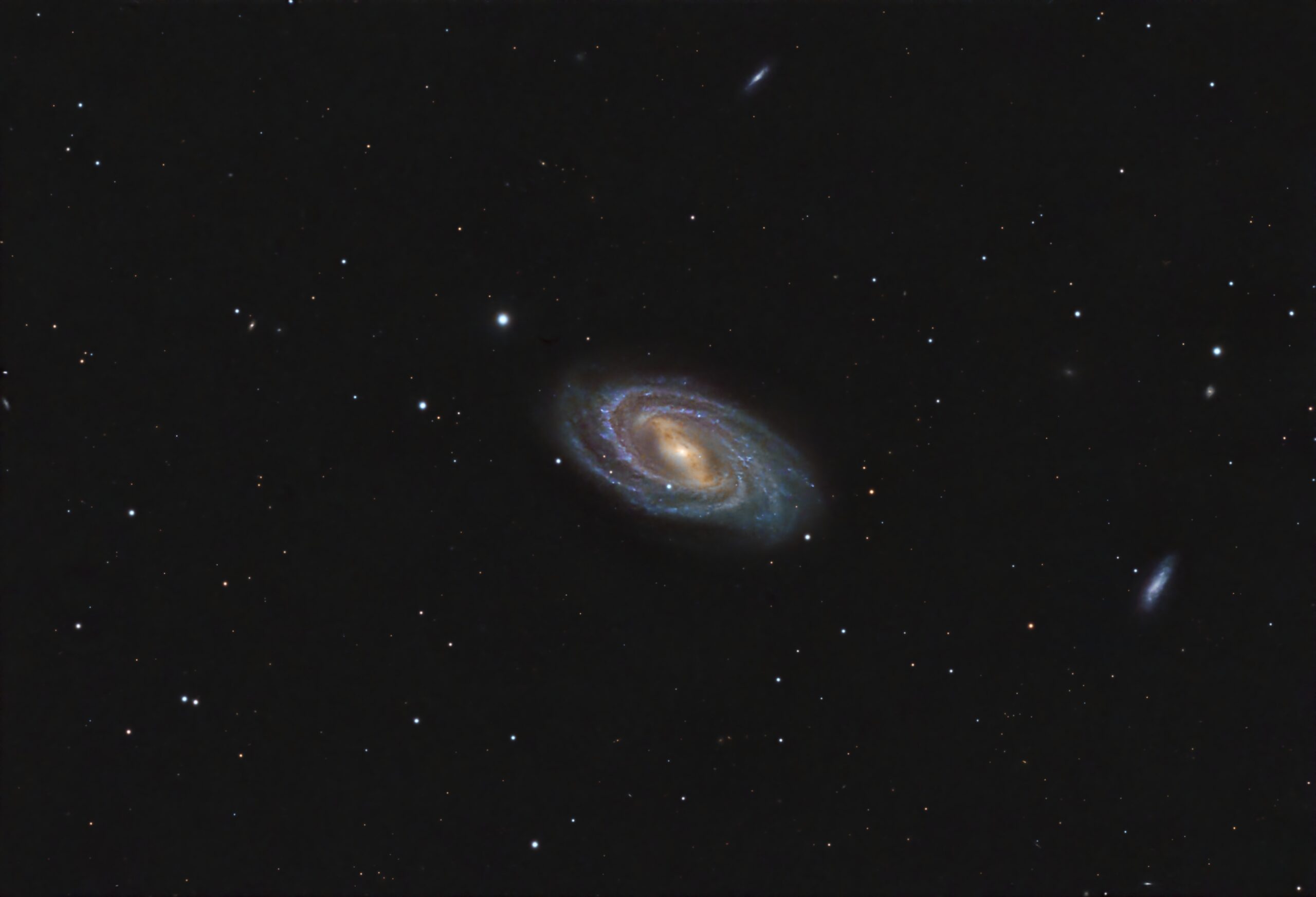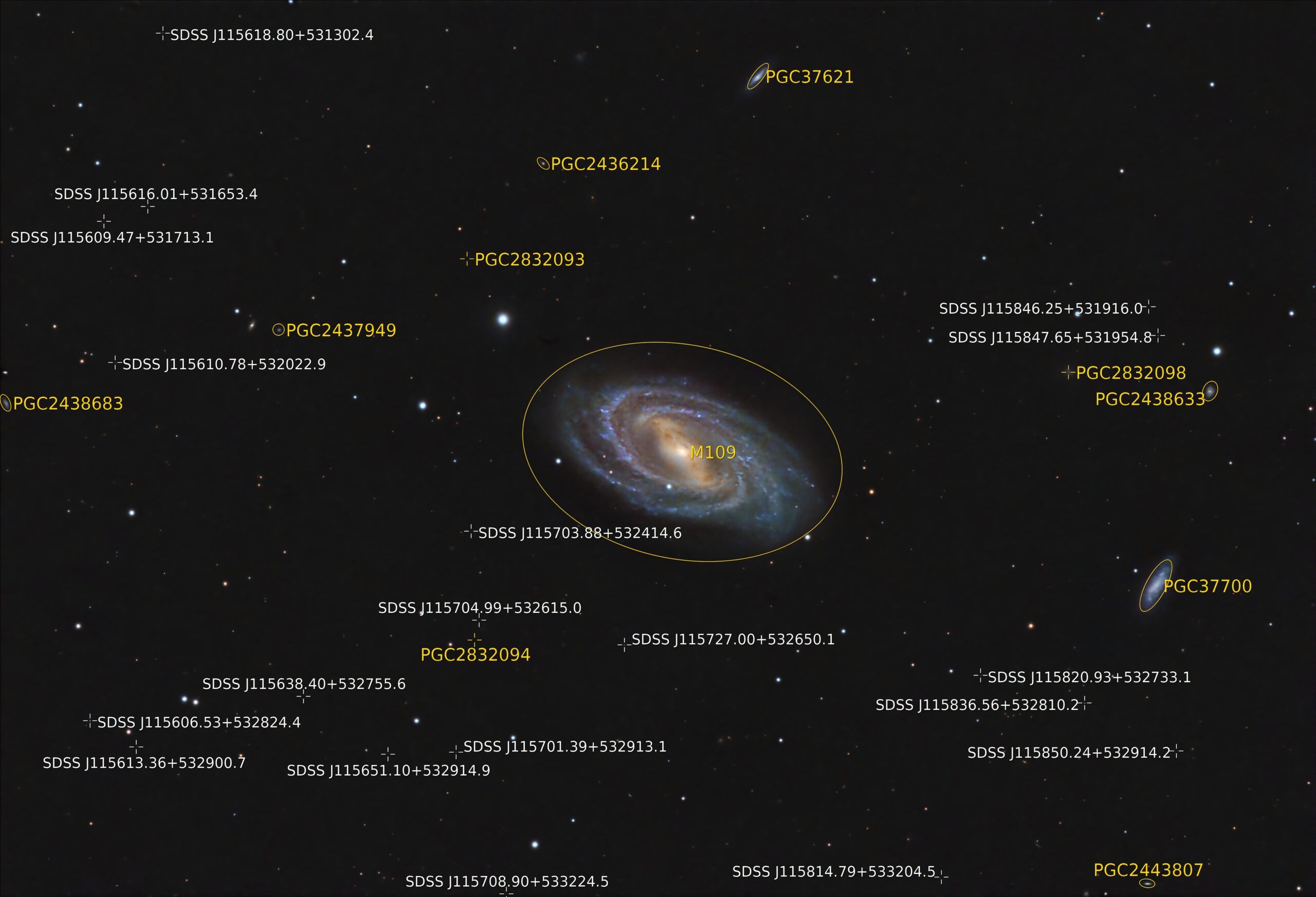M109
Click image for full size version
February 18, 2024
M109 is a barred spiral galaxy that lies around 67 million light years away in Ursa Major, plus or minus 23 million light years — this reflects some uncertainty in the distance estimates. It is considered to be the most distant Messier object, followed by M91 (the prominent sprial galaxy at upper right in this image from a few years ago).
M109 is the namesake and the largest galaxy in the M109 group of galaxies, several other members of which are also shown in this image. M109 appears in the sky close to the bright star Phecda, the bottom Big Dipper bowl star that is closest to the handle. I prepared an annotated version with galaxies highighted in yellow and quasars highlighted in white. Many of the quasars are extremely far away (billion of light years).
I imaged M109 with a different setup in 2015, but this image is far superior. This is due to a better camera, longer focal length telescope, new processing tools, and nine more years experience processing images with PixInsight. I am particularly pleased with how the dark dust in the core came out – I haven’t seen many other images that show this region so clearly.
Tekkies:
Acquisition, focusing, and control of Paramount MX mount with N.I.N.A. and TheSkyX, and PHD2 for guiding. Primalucelab low-profile 2″ Essato focuser and ARCO rotator. Equipment control with PrimaLuce Labs Eagle 4 Pro computer. All pre-processing and processing in PixInsight. Acquired from my SkyShed in Guelph. Average transparency and below-average to average seeing. Data acquired February 6-12, 2024 in a moonless sky.
Celestron 14″ EDGE HD telescope at f/11 (3,912 mm focal length) and QHY600M camera binned 2×2 with Optolong filters.
15 x 5m Red = 1hr 15mm
15 x 5m Green = 1hr 15mm
12 x 5m Blue = 1hr 00m
Total: 3hr 30m
Preprocessing: The WeightedBatchPreProcessing script was used to perform calibration, cosmetic correction, weighting, registration, local normalization, and integration of all frames. The R, G and B channels were combined with ChannelCombination.
Gradient Removal: GraXpert was applied to the RGB master.
Star Correction: BlurXterminator was applied with Correct Only checked.
Colour Calibration: ColorCalibration was used to calibrate the RGB master.
Deconvolution: BlurXterminator was applied using an automatic PSF, and star sharpening set to 0.35.
Star Removal: StarXterminator was used to remove the stars, with Unscreen selected.
Linear Noise Reduction: NoiseXterminator was applied with Amount=0.95 and Detail=0.35
Stretching: HistogramTransformation was applied to make a pleasing yet bright image. Approximate background level after stretch was 0.10
Nonlinear Processing
Nonlinear Noise Reduction: NoiseXterminator was applied with Amount=0.9 and Detail=0.15
Supplemental Stretching: HistogramTransformation was used to adjust the black point and increase brightness and contrast. Approximate background level after stretch was 0.10
Contrast Enhancement: RangeSelecton was used to make a mask of just the core of the galaxy. The MakeHDRImage script was used with color protection to compress the core of the galaxy. Then, a mask was made to select galaxies, and LocalHistogramEqualization was applied twice. A Contrast Limit of 1.5 and 1 iteration was used for each LHE application (scale 50, strength 0.22; scale 150, strength 0.20).
Sharpening: The same mask was used with MultiscaleMedianTransform to sharpen Layers 1 – 3 with strengths of 0.01, 0.03, and 0.03, respectively.
Stars-only steps: The stars-only image was stretched with HistogramTransformation. The stretch was slightly less aggressive than the sreen transfer function applied automatically by StarXterminator. CurvesTransformation CIE-c* (colourfulness) slider was used to add colour saturation to the stars through a mask made by extracting the Luminance from the stretched stars-only image.
Star Restoration: PixelMath expression combine(starless, stars, op_screen()) was used to combine the starless and stars-only images created with StarXterminator.
Final Steps: Background, galaxy and star brightness, contrast and saturation were adjusted in several iterations using CurvesTransformation with masks as required. ICCProfileTransformation (sRGB IEC61966-2.1; Relative Colorimetric with black point compensation) was applied prior to saving as a jpg. The annotated image was made with the AnnotateImage script. The finder chart was made with the FindingChart process.








Nice result, Ron.
I notice you use TGVDenoise routinely – what a great operation it is. I have successfully made very clean prints at A0 size from my STT8300, which is simply not on without TGV
Regards,
Mark